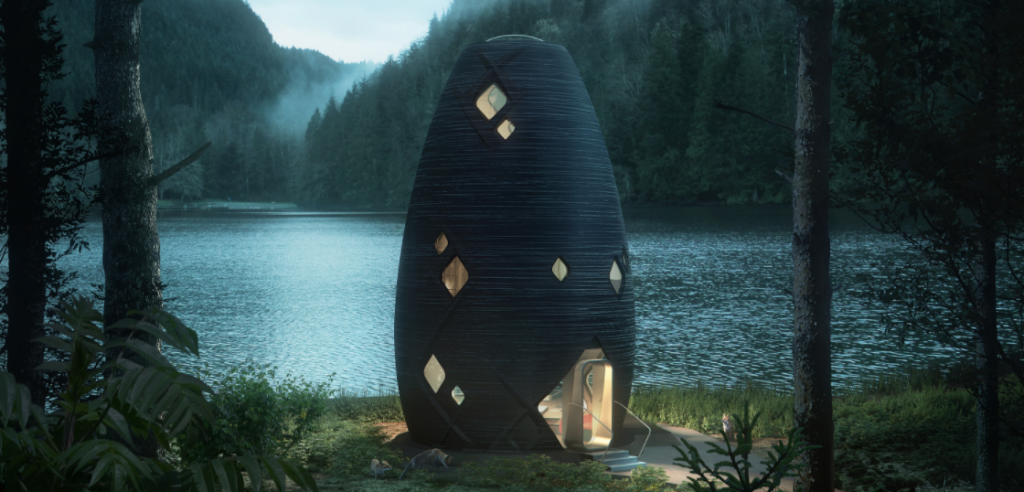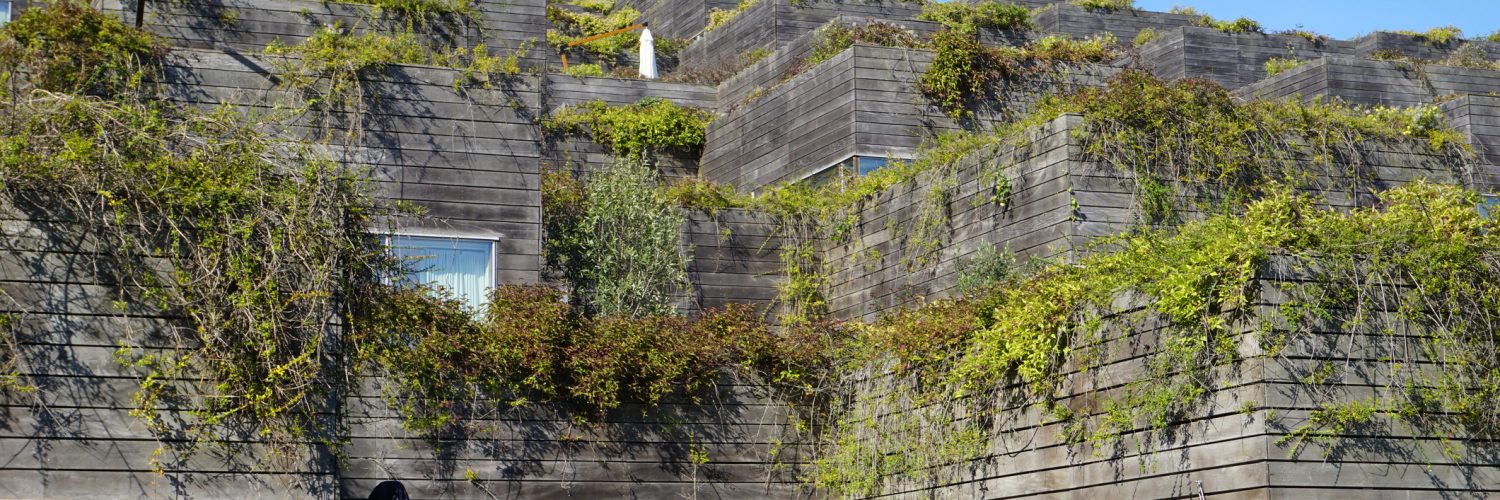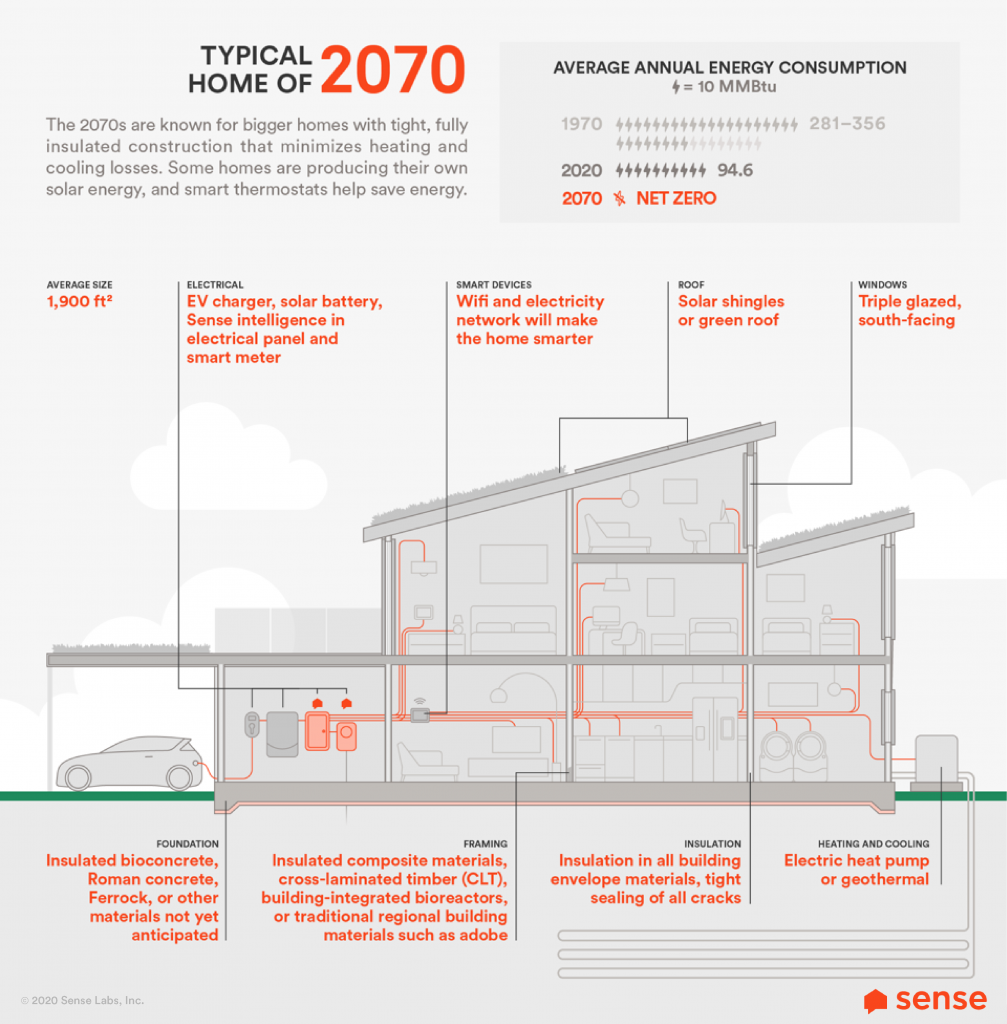
Last week, to celebrate the 50th anniversary of Earth Day, we compared homes built in 1970 to homes today. The past half-century saw big gains in home energy efficiency. Now we’re looking another half-century into the future to imagine home life in 2070. How will our homes look and behave differently in the future? How will they care for us and the world around us?
To imagine the smart, sustainable home of 2070, we talked with two home design innovators: Steve Glenn, the CEO of Plant Prefab, and Don Powers, the founder of Union Studio. Each of their companies is moving home design forward in exciting ways with sustainability as a guiding principle. We’re also sharing our own vision for the future home.
Let’s start with Sense’s vision for the smart home. Today “smart home” means voice assistants, smart thermostats, smart lighting and other gadgets that automate or bring services from the cloud into your home. Asking Siri to play your favorite music makes life more fun and convenient, but like most smart home systems, Siri works with a limited number of other products among the dozens of appliances in your home, so it doesn’t make your entire home smarter. The same can be said for most smart home products today.
At Sense, we envision a future when smarts are built into the home itself. Rather than just a collection of smart devices, the core systems of the home will become smart. Smart homes will be able to gather intelligence about the key resources entering the home, such as electricity and water, and extend that intelligence through built-in systems to the appliances that distribute and use these resources. Through this intelligent connectivity both within the home and to resources outside, homes will be able to discover problems and optimize valuable resources far more efficiently than today.
You’ll simply tell your home “Charge my car by 7 am tomorrow,” and your home will figure out how to charge it at the least cost and lowest carbon impact. Your home will tell you when appliances and devices are behaving abnormally and could soon fail. Instead of learning about a flooded basement when you step on wet carpet, you’ll get an alert from your home when it detects the sump pump turning on or water leaking from your pipes. Your smart home app will tell you that the motor in your HVAC system is failing to start – it needs to be repaired. It will tell you when your dryer is running longer than expected – probably due to a clogged vent that could cause a house fire.
Instead of burning gas or fuel oil in your house, everything will run on electricity, with the utility grid delivering energy from green, renewable sources that reduce or eliminate carbon loading in the atmosphere. Home furnaces will be converted to much more efficient heat pumps or geothermal systems that warm your home and water, and cool the air in the summer.
Your home will also remind you about the best ways to use clean energy. For instance, it might prompt you to turn on your dishwasher or washing machine when solar power is produced abundantly on your roof or from the energy grid. Or, even more conveniently, you’ll fill the dishwasher and tell your home when your next meal will be. The dishwasher will turn itself on when the energy cost is lowest, responding to information from the utility grid and your solar roof. When you go on vacation, your home will hibernate in low-energy mode until you return.
In many ways, homes will function much like today’s cars, which have intelligence built into them that alerts you about repairs or routine maintenance. Fifty years ago, cars were entirely mechanical devices. You needed to remember when to bring the car in for a checkup, and if it broke down, you needed to tow it to a service station.
Today cars are a blend of mechanical and computer technology. Indicators in the dashboard alert you to failures and remind you to take your car into the shop, where a mechanic runs a diagnostic and makes a repair. In the same way, homes will have intelligence built into them that diagnose and automate maintenance.
Smart homes will share information that makes it easier for you to take care of your home, and your 2070 smart home will take better care of you, too. Of course, your home can’t do everything. If you leave the house with the stove on, your home app can remind you, but you need to turn it off. Also, smart home systems will need to be designed to empower homeowners to make their own choices on a day-to-day basis, while automating key tasks based on home and grid intelligence.
At Sense, we expect that many of these capabilities will be integrated into homes in the coming decade, and by 2070, the capabilities will be even more seamless and sophisticated.
To understand how other aspects of the home will change in the coming half-century, we asked two innovators who are pushing the boundaries of sustainable home design to predict what the future holds. We wanted to know how homes will look, how they’ll fit into the environment, what materials they’ll be made out of and how much energy they’ll use — and, of course, did they agree that homes will be smarter?
We talked with Steve Glenn, the CEO of Plant Prefab and Don Powers, the founder of Union Studio. Plant Prefab specializes in pre-fabricated designs, including accessory dwelling units like LivingHome 10, a miniature smart home with about 500 square feet of living space. This Old House profiled the transformation of Don Powers’ Craftsman cottage in Jamestown, Rhode Island, to make it net zero. His designs combine sustainability with respect for historical and regional roots.
While their answers were wide ranging, both designers agreed that homes in 2070 will produce at least as much energy as they use, and they shared our belief at Sense that smart home technology will be built right into the house itself.

Homes now have a significant, negative ecological footprint – they use more energy than they produce, they don’t save/reuse water, and they can be unhealthy. By 2070, the opposite will be true: they will produce more power than they use; they will capture and recycle water; they’ll filter air, creating healthy indoor environments.
Steve Glenn, Plant Prefab
My dream is that we could rediscover how to build enduring places that people love and want to maintain, places that people have enough real affection for they couldn’t conceive of tearing down. The most sustainable home is, by definition, the one that has sustained the longest. Are we building Beacon Hill in Boston or Provincetown, MA – places that people will continually want to save and inhabit for a hundred years? Or are we building “units of housing” that will be torn down just as soon as the market determines that a newer model would sell faster?
Don Powers, Union StudioHow will the home of 2070 be different from today’s home from an ecological perspective?
DP: Houses will certainly be more energy efficient at every level, both in terms of conservation and using renewable sources like solar and wind. The “net zero” home will be more the rule than the exception. Also, there will be a quantum level reduction in plastics, petroleum-based products, and generally, in any material that is not reasonably locally sourced.
Will the future home look different from today’s homes?
SG: By 2070, most building materials will likely be grown or recycled from existing materials so homes will have a much more organic, biophilic design. Cities will be much denser to accommodate a dramatically larger population, so buildings (multi family homes) will be far taller than they are today.
DP: On the whole, I think the average home will be recognizable and somewhat traditional. For most people. one of the functions of a home is psychological comfort and reassurance. Many architects and home designers are so enamored of cutting edge technology that they try to reflect it in the design elements of the house. This attitude overlooks the role our homes play in re-stating and confirming the values of their owners, and those values tend to change much more gradually than technology.
What kinds of materials will be used that are not common today?
SG: Structural and finish materials that are grown in labs from organic matter and that are produced from recycled products: cars, tires, or plastic.
DP: I’d ask the question the other way: Which materials won’t be in use that are commonly used today? There will be a huge move towards sustainably produced, locally sourced, “organic” materials. We’ll return to the basics such as wood, stone, brick, and plaster. Plastics, petroleum-based products and products and assemblies that require large amounts of embodied energy to make will fall out of favor. Fiberglass insulation, for example, will be replaced by natural wool, cotton, or wood fiber based systems. Vinyl siding will be banned. Drywall, which is very energy intensive to make, will be used far less, with natural FSC certified wood finishes replacing it.
What kinds of building techniques will be used?
DP: We may see a return to local, traditional techniques that were developed as a response to local climate and locally available building materials.
How will the home relate to its community, region, or setting?
DP: I believe we’re entering a time of increased localness. A home’s design and construction may respond more to local variables than it has for this past century of abundant oil. As James Howard Kunstler writes in The Long Emergency, the “fiesta” of cheap oil has allowed us to virtually ignore the actual climate, knowing we could heat or cool ourselves no matter how inefficiently we built.
How will the 2070 home help the environment?
SG: They will create power themselves, thus not requiring power from the grid. They’ll capture and filter water (from sinks, toilets), meaning they need very little or no external water. They’ll help to filter the air, creating better indoor air quality.
DP: It is entirely possible that we will have gone beyond “net zero” and created a network of connected homes that is actually energy positive. Certainly, if we’re using every rooftop to generate solar energy, and we solve the storage (battery) problem, we will ween off fossil fuel completely.
How big will the future home be?
SG: Small! 100-200 square feet for individuals. Double or triple for families.
DP: After 60 years of growing, the average home size began to decrease in 2009. I think the home of the future will be smaller but better designed – probably less than 2000 SF.
What kinds of smart technology will the 2070 home have? How will it be integrated into the home and how will smart technology help people?
SG: There will be the same categories that exist now – smart locks, HVAC control, entertainment systems and security – only the systems will be integrated in ALL homes, including rentals, and you’ll be able to access and control from your phone, which by 2070 will likely be embedded technology in us all! Televisions will be totally flat and will cover walls, allowing for moving landscapes that help people feel more comfortable in their compact spaces.
DP: The home will be an integrated system of smart devices controlled by our handheld devices. I predict we will settle on a digital architecture and infrastructure that is simple and can support endless cycles of improvement, much like the basic smart-phone technology that is now agreed upon and supports endless innovation in the form of apps that all play by the same rules.
How will the 2070 home help the environment?
SG: They will create power themselves, thus not requiring power from the grid. They’ll capture and filter water (from sinks, toilets), meaning they need very little or no external water. They’ll help to filter the air, creating better indoor air quality.





















